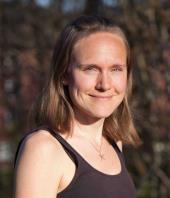Malin Olofsson

Presentation
I am involved in several different project related to phytoplankton including cyanobacteria of various types, here are a few examples:
- Phytoplankton-bacteria interaction and labile carbon transfer during different growth stages, diel cycles and temperatures using transcriptomics and metabolomics (VR International Post Doc).
- Nitrogen fixing cyanobacteria in the Baltic Sea including the use of stable isotope incubation experiments, biogeochemical models, and monitoring data (ÅForsk repatriation grant).
- Two projects on monitoring and anlyses of algal toxins, both in freshwater and seawater, mainly focusing on cyanobacteria and assimilated in mussels (Board of Agriculture).
Selected publications
23. Uchimiya M, Olofsson M, Powers MA, Hopkinson BM, Moran MA, Edison AS. (2023) 13C NMR metabolomics: J-resolved STOCSY meets INADEQUATE. J. Magnetic Resonance. 347: 107365.
22. Ferrer-González FX, Hamilton M, Smith CB, Schreier JE, Olofsson M, Moran MA. (2023). Bacterial transcriptional response to labile exometabolites from photosynthetic picoeucaryote Micromonas commoda. ISME Commun. 3: 5.
21. Karlson B, Arneborg L, Johansson J, Linders J, Liu Y, Olofsson M. (2022) A suggested climate service for cyanobacteria blooms in the Baltic Sea – Comparing three monitoring methods. In press.
20. Olofsson M, Ferrer-González FX, Uchimiya M, Holderman N, Schreier JE, Smith CB, Edison AS, Moran MA. 2022. Growth-related shifts in phytoplankton metabolome triggered by the presence of heterotrophic bacterial. ISME Commun. 2, 28.
19. Moran MA, Ferrer-González F, Fu H, Nowinski B, Olofsson M, Powers M, Schreier J, Schroer W, Smith C, Uchimiya M. 2022. The Ocean´s labile DOC supply chain. Limnol. Oceanogr. Doi: 10.1002/lno.12053.
18. Olofsson M, Almén A-K, Jaatinen K, Scheinin M. Temporal escape – adaptation to eutrophication by Skeletonema marinoi. Accepted for FEMS Microb Lett. 2022.
17. Uchimiya M, Schroer W, Olofsson M, Edison AS, Moran MA. Diel investments in metabolite production and consumption in a model microbial system. In print for ISME J 2022.
16. Hieronymus J, Eilola K, Olofsson M, Hense I, Meier MEM, Almroth-Rosell E. Modeling cyanobacteria life cycle dynamics and historical nitrogen fixation in the Baltic Sea. Accepted for Biogeosciences October 2021.
15. Olofsson M, Power M, Stahl DA, Vadeboncoeur YM, Brett MT. (2021) Cryptic constituents: The paradox of high flux – low concentration constituents in aquatic ecosystems. Water 13(16): 2301.
14. Olofsson M and Wulff A. (2021) Looking back to the future - Phytoplankton diversity and productivity in the Arctic. Marine Biodiversity 51: 61.
13. Olofsson M*, Hagan J*, Karlson B, Gamfeldt L (2020) Large seasonal and spatial variation in nano- and microphytoplankton diversity along a Baltic Sea – North Sea salinity gradient. Scientific Reports 10: 17666. * = contributed equally
12. Olofsson M, Klawonn I, Karlson B (2021) Nitrogen fixation estimates for the Baltic Sea indicate high rates for the previously overlooked Bothnian Sea. Ambio 50(1): 203-214.
11. Stenow R, Olofsson M, Robertson EK, Kourtchenko O, Whitehouse MJ, Ploug H, Godhe A. (2020) Resting stages of Skeletonema marinoi assimilate nitrogen from the ambient environment under dark, anoxic conditions. J. Phycology. Doi: 10.1111/jpy.12975.
10. Olofsson M, Suikkanen S, Kobos J, Wasmund N, Karlson B (2020) Basin-specific changes in filamentous cyanobacteria community composition across four decades in the Baltic Sea. In press for Harmful Algae 91: 101685.
9. Olofsson M,Robertson EK, Edler L, Arneborg L, Whitehouse MJ, Ploug H (2019) Nitrate and ammonium fluxes to diatoms and dinoflagellates at a single cell level in mixed field communities in the sea. Sci Rep. 9: 1424
8. Olofsson M, Kourtchenko O, Zetsche E-M, Marchant H, Whitehouse MJ, Godhe A, Ploug H (2019) High single-cell diversity in carbon and nitrogen assimilations by a chain-forming diatom across a century. Environ Microbiol. 21(1): 142-151
7. Olofsson M, Torstensson A, Karlberg M, Steinhoff SF, Dinasquet J, Riemann L, Chierici M, Wulff A (2019) Limited response of a spring bloom community inoculated with filamentous cyanobacteria to elevated temperature and pCO2. Bot Mar. 62(1): 3-16.
6. Wulff A, Karlberg M, Olofsson M, Torstensson A, Riemann L, Steinhoff SF, Mohlin M, Ekstrand N, Chierici M (2018) Ocean acidification and desalination: climate-driven change in a Baltic Sea summer microplanktonic community. Mar Biol 165: 63.
5. Olofsson M, Karlberg M, Lage S, Ploug H (2017) Phytoplankton community composition and primary production in the tropical tidal ecosystem, Maputo Bay (the Indian Ocean). J Sea Res. 125: 18-25.
4. Olofsson M, Egardt J, Singh A, Ploug H (2016) Inorganic phosphorus enrichments in Baltic Sea water have large effects on growth, carbon fixation and N2 fixation by Nodularia spumigena. Aquat Microb Ecol 77:111-123.
3. Klawonn I, Nahar N, Walve J, Andersson B, Olofsson M,Svedén BJ, Littmann S, Whitehouse MJ, Kuypers MMM, Ploug H (2016) Cell-specific nitrogen- and carbon-fixation of cyanobacteria in a temperate marine system (Baltic Sea) Environ Microb 18(12): 4596-4609.
2. Eriander L, Infantes E, Olofsson M, Olsen J, Moksnes P-O (2016) Assessing methods for restoration of eelgrass (Zostera marina L.) in a cold temperate region. J Exp Mar Bio Ecol 479: 76-88.
1. Olofsson M, Asplund M E, Karunasagar I, Rehnstam-Holm A-S, Godhe A (2013) Prorocentrum micanspromote and Skeletonema tropicum disfavours persistence of the pathogenic bacteria Vibrio parahaemolyticus. Indian Journal of Geo-Marine Sciences 42: 729-733.
Popular Science papers
2. Malin Olofsson & Helle Ploug (2019) Kiselalgen – livsviktig överlevnadsexpert. Havsutsikt nr 2.
1. Malin Olofsson & Helle Ploug (2017) Nya metoder avslöjar cyanobakteriernas roll i Östersjön. Havsutsikt nr 1.